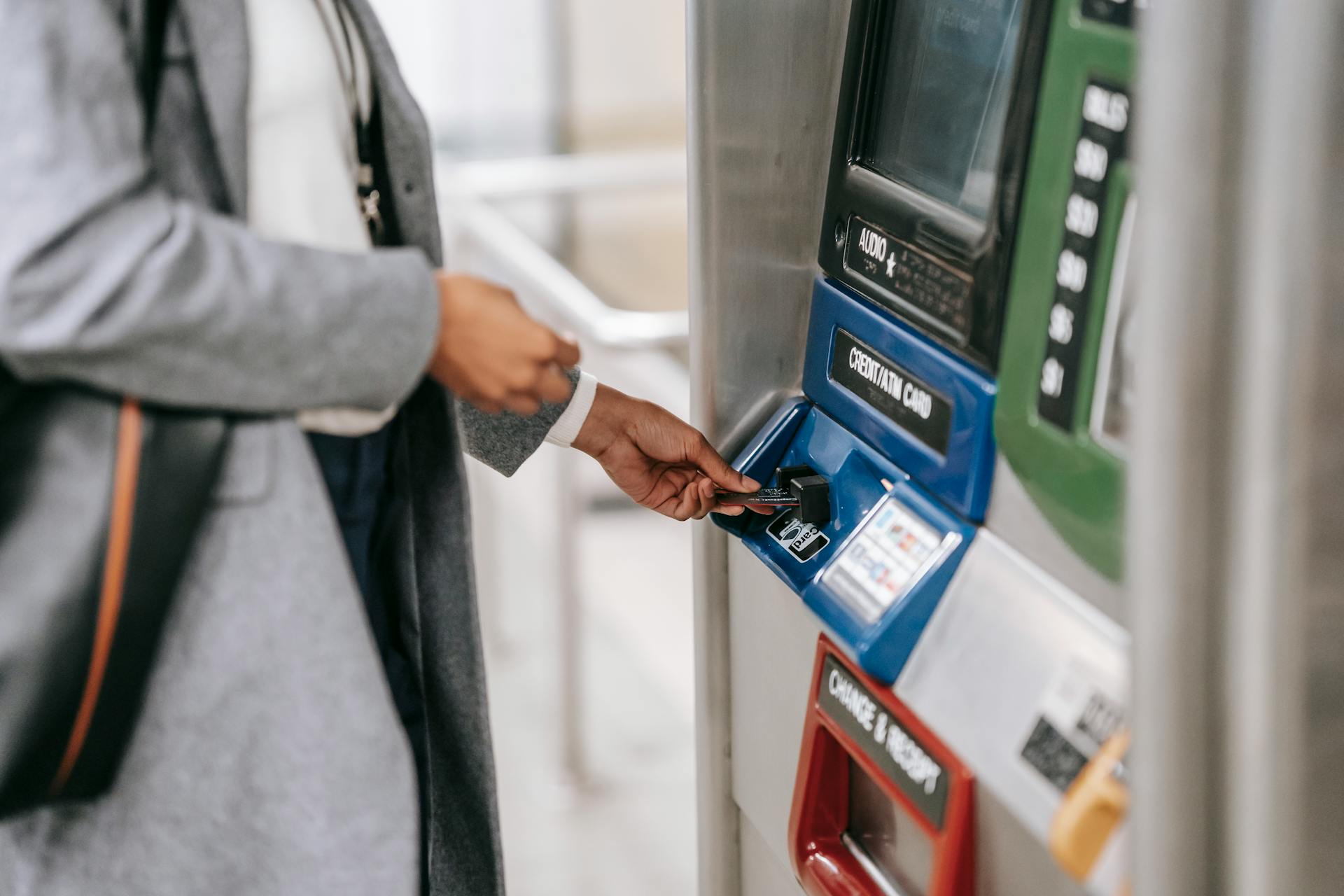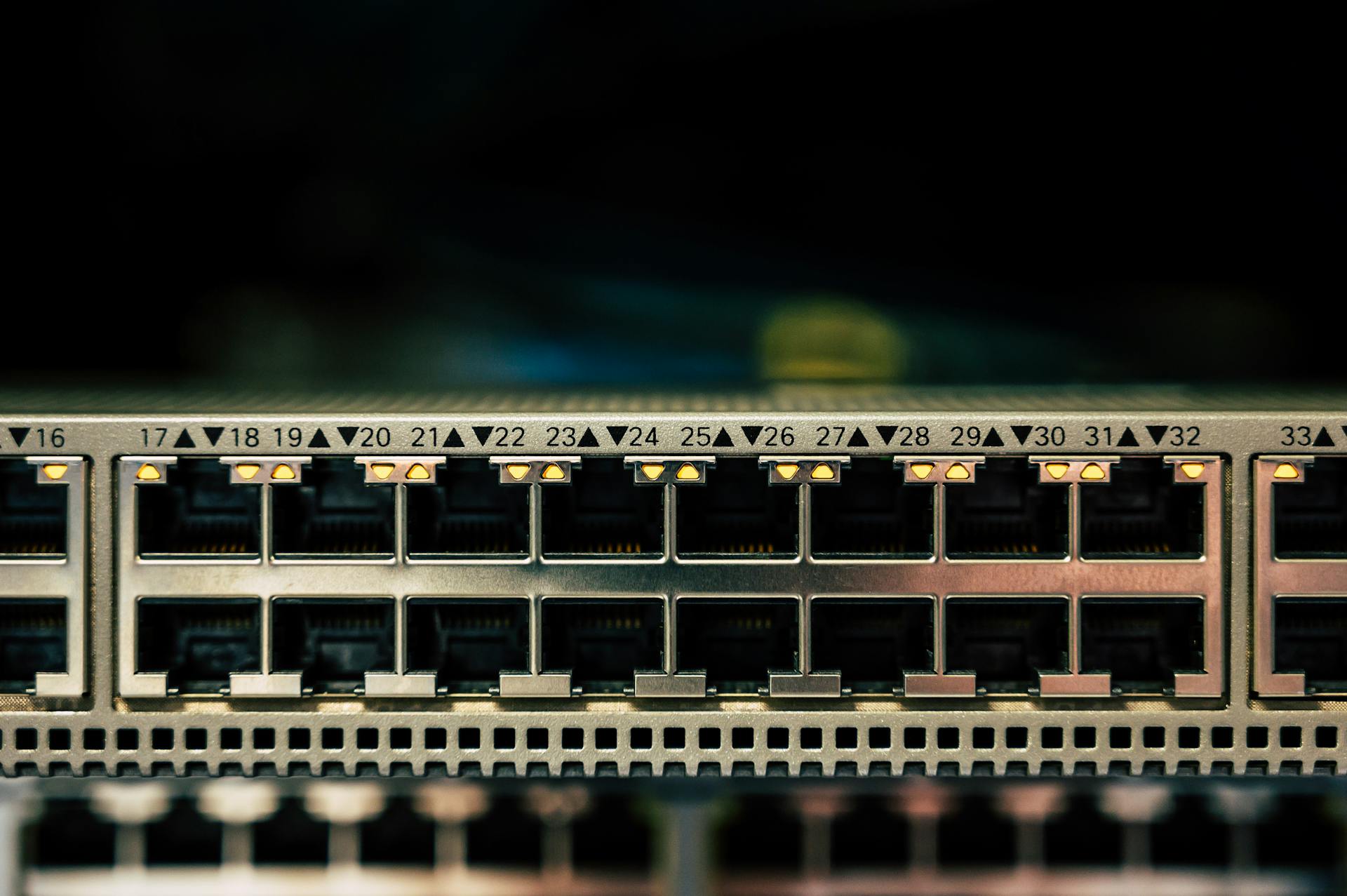
Payment networks are the backbone of modern commerce, facilitating transactions between buyers and sellers worldwide. They are essentially electronic highways that enable the transfer of funds.
Each payment network has its own set of rules and fees, which can vary depending on the type of transaction and the parties involved. For example, some payment networks charge a flat fee for each transaction, while others charge a percentage of the transaction amount.
Payment networks work by connecting merchants, banks, and other financial institutions, allowing them to communicate and exchange information about transactions. This enables the instant transfer of funds from one account to another.
In essence, payment networks are the invisible infrastructure that makes online shopping, mobile payments, and other digital transactions possible.
For more insights, see: 2 Wifi Networks
Types of Payment Networks
There are several types of payment networks, each with its own unique characteristics. Credit card networks are one type, and they can be open-loop or closed-loop. Open-loop credit cards, like Visa, can be used anywhere their network is accepted, while closed-loop credit cards, like those issued by Home Depot, can only be used in that specific store.
Closed-loop credit card networks, like American Express and Discover, cut out the issuing bank and work directly between the customer and the merchant's payment processing system. This means that if you get an Amex Platinum Card, it's just that—a card issued by Amex, using the Amex network.
Some examples of payment networks include Visa, Mastercard, American Express, and Discover, which are the four main credit card payment networks. Each network facilitates transactions between cardholders, merchants, and banks, ensuring secure and seamless payments.
ACH
ACH payments are a type of electronic funds transfer that allows for direct transfers between bank accounts.
They're commonly used for payroll, bill payments, and business transactions, which is why you'll often see them used for bulk transactions like payroll deposits.
ACH payments are processed through secure computer-based systems that verify transaction details in real time, making them a reliable option for transferring funds.
The processing time for ACH payments is typically within a few business days, which is why you might see funds deposited into a merchant's account within one to two business days.
These systems are designed to facilitate the transfer of funds from one account to another, often with minimal fees and no need for intermediaries.
Check this out: Send Ach Payments Online
Peer-to-Peer (P2P)
Peer-to-Peer (P2P) payment networks enable individuals to send and receive money directly from one another. Some popular examples include Venmo, PayPal, and Zelle.
These networks don't require cheques or physical cash to transfer funds. Users can send money using an email address or phone number associated with the recipient's account.
P2P networks support various payment methods, such as bank transfers, credit and debit cards, and sometimes even cryptocurrencies. This makes financial interactions more convenient and accessible.
They play a significant role in both business and personal finance by facilitating quick payments for services, splitting bills, or sending gifts.
Innovation
Payment networks are constantly evolving to meet the changing needs of their users. This is evident in their commitment to innovation.
One way they achieve this is by developing new technologies to enhance the user experience. This can include features like faster transaction processing and more secure payment methods.
Payment networks continually develop new technologies and services to enhance the user experience. This allows them to stay ahead of the curve and provide their users with the best possible experience.
As a result, users can enjoy a more seamless and convenient payment experience.
Central Bank Digital Currencies (CBDCs)
Central Bank Digital Currencies (CBDCs) are changing the game for global payments. They're digital currencies issued by central banks, promising greater efficiency and financial inclusion. China and the Bahamas are leading the way in CBDC development.
These digital currencies could offer central banks more control over monetary policy. The Bahamas, for example, is at the forefront of CBDC development.
Issuer
The issuer is the company that gives the credit card to the customer and maintains the customer's credit account.
They handle the customer account side of things, including charging annual fees and interest, handling purchase disputes, resolving cases of credit card fraud, and offering rewards.
American Express and Discover are notable examples of companies that operate on closed networks and handle both the customer account side and the background flow of information between the customer and the merchant.
They're responsible for keeping track of the customer's account information and ensuring that transactions are processed smoothly.
If this caught your attention, see: Financial Account of Balance of Payment
What Are the 4?
The four main credit card payment networks are: Visa, Mastercard, American Express, and Discover. Each of these networks has its own unique features and benefits.
Visa is the largest network, widely accepted worldwide. It's what you likely think of as a typical credit card.
Mastercard is known for its security features and global reach. You can use it just about anywhere.
American Express is a closed-loop network offering premium cardholder perks. This means it works directly between the customer and the merchant's payment processing system, cutting out the issuing bank.
Discover focuses on cashback rewards and simple fee structures. It's a great option for those who want to earn rewards without the hassle of complicated fees.
Here are the four main credit card payment networks at a glance:
How Payment Networks Work
Payment networks are the backbone of credit card transactions, and understanding how they work is essential for any business owner or individual who uses credit cards.
A payment network is responsible for verifying whether a transaction can be approved based on available funds and other factors like fraud detection.
Here's a simplified overview of the key steps involved in a payment transaction through a network:
- Customer gives their credit card to the merchant.
- Merchant submits the payment information to the credit card processor.
- Credit card processor contacts the acquiring bank.
- Acquiring bank contacts the credit card network.
- Credit card network contacts the issuing bank.
- Issuing bank approves the transaction and sends payment to the acquiring bank.
- Acquiring bank holds the payment for the credit card processor.
- Credit card processor passes the payment on to the merchant.
Business owners who accept credit cards need a merchant account for those payments, which can be obtained directly from an acquiring bank or through a full-service payment processor.
Authorization Request
The authorization request is a crucial step in the payment process, and it's all about verifying whether a transaction can be approved. This step is triggered when a payment terminal or gateway sends an authorization request to the payment processor, which then forwards it to the card network.
The card network, such as Visa or Mastercard, is responsible for routing the request to the issuing bank, the bank that issued the customer's card. This is where the issuing bank checks the cardholder's account to ensure sufficient funds are available and performs a security check to identify any potential fraudulent activity.
Explore further: What Is a Virtual Card Payment
Here's a simplified overview of the authorization request process:
As you can see, the authorization request process involves several key players, including the payment processor, card network, and issuing bank. It's a critical step in ensuring that transactions are legitimate and that funds are available for payment.
Contactless
Contactless payments have become incredibly popular, with a 40% growth in 2022 according to a Mastercard study, showing consumers love the speed and convenience.
This method uses Near Field Communication (NFC) technology to eliminate the need for physical contact, making it a more secure option too.
Contactless payments are now a staple in many daily transactions, and it's easy to see why with the benefits they offer.
Additional reading: Limit of Contactless Payments
Payment Network Process
A payment network process is initiated when a customer starts a transaction by providing payment details, typically through a credit card, debit card, mobile wallet, or other electronic payment methods.
The payment network is activated, starting the process of transferring funds from the customer's account to the merchant's account.
Suggestion: Processing Debit Card Payments
Electronic Funds Transfer (EFT) networks operate by using secure, computer-based systems to verify transaction details and facilitate fund transfers between accounts.
EFTs include Automated Clearing House (ACH), wire transfers, and the Clearing House Interbank Payments System (CHIPS), which process bulk transactions, immediate fund transfers, and large-volume payments between financial institutions.
The payment processor handles the flow of information and money between the business owner and the credit card network, which transfers money and information between the customer's credit account and the business owner's payment processor.
At the end of the business day, the merchant sends a batch of approved transactions to the payment processor for settlement, which is then forwarded to the respective issuing banks.
The issuing banks transfer the funds to the acquiring bank (the merchant's bank), minus any fees, completing the settlement process and depositing the funds into the merchant's account within one to two business days.
A different take: Online Payments for Business
Benefits and Features
Payment networks offer convenience and speed, streamlining transactions with instant processing and easy access to funds. This is crucial for both consumers and businesses today.
Instant processing is a major benefit, allowing transactions to happen quickly and efficiently. This saves time and reduces the risk of delays.
Easy access to funds is also a key feature, giving consumers and businesses the flexibility they need to manage their finances effectively.
A fresh viewpoint: Medical Payment Processing
Convenience and Speed
Convenience and Speed are crucial for consumers and businesses today.
Payment networks offer instant processing, which is a game-changer for anyone who's ever waited for a payment to go through.
This convenience is especially important for businesses, as it allows them to access funds quickly and make informed financial decisions.
Instant processing also means that consumers can access their funds right away, which is a huge relief for anyone who's ever been stuck with a delayed payment.
A fresh viewpoint: Echeck Payment Processing Time
Economies of Scale
Economies of scale are a key benefit of using networks, allowing them to process a high volume of transactions and achieve cost efficiencies, leading to lower transaction fees.
By processing a large number of transactions, networks can spread their fixed costs across a larger volume, reducing the cost per transaction.
This can result in significant savings for users, making transactions more affordable and increasing overall adoption of the network.
In fact, networks can achieve cost efficiencies of up to a certain percentage by processing a high volume of transactions, making them a more attractive option for users.
Challenges and Risks
Payment networks face numerous challenges and risks, including fraud and security threats. Data breaches can expose sensitive customer information, making it a serious concern for merchants and consumers alike.
Payment networks are constantly under threat from cybercriminals, who seek to exploit vulnerabilities in the system. Unauthorized transactions, such as fraudulent use of stolen payment credentials, are a major issue.
Unauthorized transactions can harm merchants financially and damage their reputation. Chargebacks, which are disputes over transaction legitimacy, can also harm merchants.
Here are some common types of security threats faced by payment networks:
- Data breaches: Exposing sensitive customer information.
- Unauthorized transactions: Fraudulent use of stolen payment credentials.
- Chargebacks: Disputes over transaction legitimacy that can harm merchants.
Fraud and Threats
Fraud and threats are a major concern for payment networks. They're constantly under attack from cybercriminals who try to exploit vulnerabilities to steal sensitive customer information.
Data breaches can expose sensitive customer information, leaving them vulnerable to identity theft and other malicious activities. This can be devastating for individuals and businesses alike.
Unauthorized transactions are another common threat. These are transactions that occur when someone uses stolen payment credentials to make purchases online or offline.
Chargebacks can also be a problem. These are disputes over transaction legitimacy that can harm merchants who have already processed the payment.
Payment networks employ advanced security measures to mitigate these risks. These include encryption, tokenization, and fraud detection systems.
Regulatory Compliance
Regulatory Compliance is a significant challenge for payment network operators. They must comply with anti-money laundering (AML) and counter-terrorism financing (CTF) laws.
Payment networks operate within a complex regulatory environment, subject to rules and regulations from multiple jurisdictions. This makes it difficult to stay updated with evolving regulations.
Compliance with data privacy laws is also essential for payment network operators. They must protect sensitive customer information.
Staying updated with evolving regulations is a significant challenge for payment network operators. It requires constant monitoring of changing laws and regulations.
Do Retailers Prefer Cash?
Retailers have different preferences when it comes to payment methods. Some prefer cash because there aren’t any transaction fees associated with it.
Many small businesses in the U.S. prefer cash for this reason. Online businesses that don’t operate physical storefronts often prefer credit cards instead.
See what others are reading: Cash Advance Network
Frequently Asked Questions
What are the 4 payment networks?
The four main payment networks are Visa, Mastercard, American Express, and Discover, which enable secure transactions between customers, businesses, and banks. These networks provide a secure and efficient way to process payments worldwide.
Which payment network is best?
While opinions may vary, Visa is widely considered the most widely used card payment system globally, offering both credit and debit card options. However, the "best" payment network ultimately depends on individual needs and preferences.
What is the most used credit card network?
Visa is the most widely used credit card network, accounting for 37% of all credit cards in circulation. This is followed closely by Mastercard, which makes up 32% of the global credit card market.
Featured Images: pexels.com


